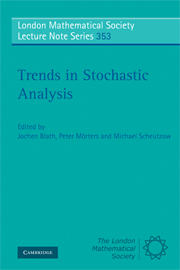Book contents
- Frontmatter
- Contents
- Preface
- Heinrich von Weizsäcker's students
- Heinrich von Weizsäcker's publications
- I Foundations and techniques in stochastic analysis
- 1 Random variables – without basic space
- 2 Chaining techniques and their application to stochastic flows
- 3 Ergodic properties of a class of non-Markovian processes
- 4 Why study multifractal spectra?
- II Construction, simulation, discretization of stochastic processes
- III Stochastic analysis in mathematical physics
- IV Stochastic analysis in mathematical biology
4 - Why study multifractal spectra?
Published online by Cambridge University Press: 05 March 2012
- Frontmatter
- Contents
- Preface
- Heinrich von Weizsäcker's students
- Heinrich von Weizsäcker's publications
- I Foundations and techniques in stochastic analysis
- 1 Random variables – without basic space
- 2 Chaining techniques and their application to stochastic flows
- 3 Ergodic properties of a class of non-Markovian processes
- 4 Why study multifractal spectra?
- II Construction, simulation, discretization of stochastic processes
- III Stochastic analysis in mathematical physics
- IV Stochastic analysis in mathematical biology
Summary
Abstract
We show by three simple examples how multifractal spectra can enrich our understanding of stochastic processes. The first example concerns the problem of describing the speed of fragmentation in a stick-breaking process, the second concerns the nature of a phase transition in a simple model of statistical mechanics, and the third example discusses the speed of emergence in Kingman's coalescent.
Introduction
I am often asked why I am interested in Hausdorff dimension. Are there any important problems that can be solved using Hausdorff dimension? Can Hausdorff dimension really add to our understanding of stochastic processes? I believe that the answer is yes to both questions, and in this paper I attempt to give some evidence in the case of the second question, by means of three examples. I will focus on the notion of a multifractal spectrum or dimension spectrum, which in its broadest form refers to the Hausdorff dimension of a parametrized family of sets, seen as a function of the parameter.
The examples are chosen on the one hand for their relative simplicity, on the other hand to illustrate the diversity of shapes which a multifractal spectrum can take. A common thread in all the examples is the notion of a tree, which either features prominently in the initial description or presents a very valuable reformulation of the model.
- Type
- Chapter
- Information
- Trends in Stochastic Analysis , pp. 99 - 120Publisher: Cambridge University PressPrint publication year: 2009
- 3
- Cited by



